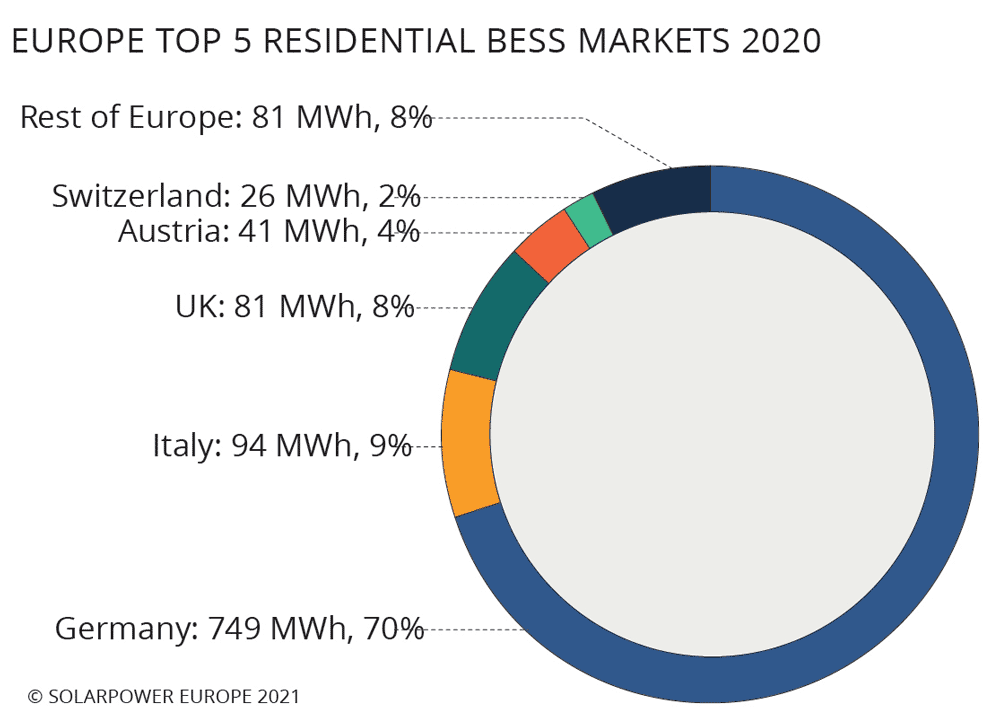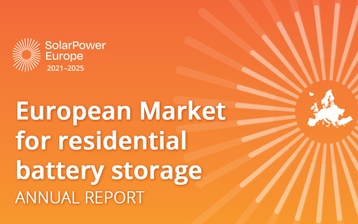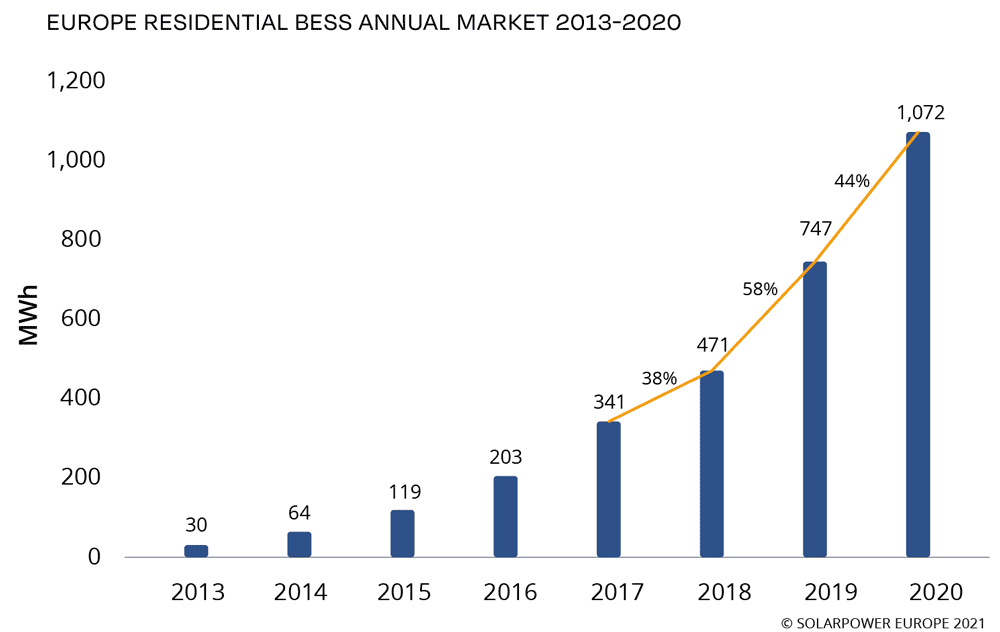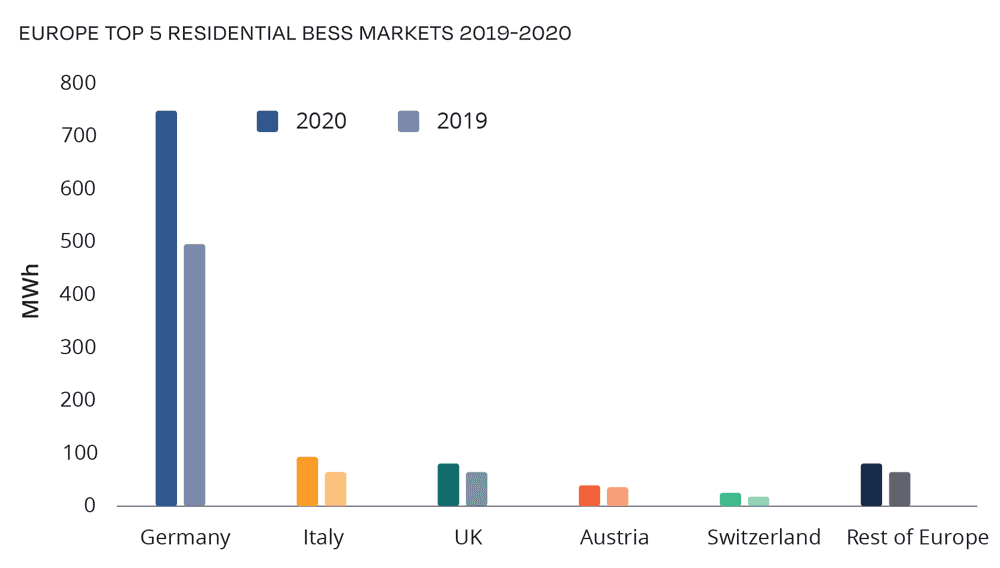Solar Power Europe published the European Market Outlook for Residential Battery Storage 2021-2025 at the end of 2021.
The historical data are up to 2020 while for 2021 and subsequent ones they are forecasts.
The assumptions on the market trend are divided into 3 distinct scenarios:
- Average scenario: anticipates the most probable evolution of the market considering the current situation
- Low Scenario: assumes that there may be financial crises and / or changes at the political / legislative level that require a decrease in support and incentives to the storage market.
- High Scenario: provides that all political and financial situations in support of the installations are better than the current situation.
Starting from the historical data held by Solar Power Europe, 2020 was the first year in which in Europe the installations of residential storage systems (BESS Battery Energy Storage Systems) exceeded, albeit slightly, the GW, more precisely 1,072 MWh, and it is also the first year that more than 100,000 homes have had a new battery installed, properly around 140,000.
Final 2019 residential accumulation
The 2019 final balance instead stood at 747 MWh, or +58% compared to 2018 which brought with it 471 MWh of residential accumulations, so in just two years there has been a doubling, with considerable number if we think that in 2015, or 5 years before this consumptive, the total European market counted only 119 MWh.
In 2020, last year’s forecasts were improved, the first in which Solar Power Europe published data and forecasts on residential storage in Europe in addition to the classic ranking on the photovoltaic sector.
The forecasts indicated a +9% equivalent to 800 MWh in the average scenario, and only the high scenario predicted 1,000 MWh.
Expectations for the normal scenario are 1.37 GWh
The expectations for the average scenario are 1.37 GWh of installed capacity for 2021 with a + 28% compared to what was achieved in 2020, continuing the expectations for 2025, the last year of this forecast, the market, without positive or negative jolts, it should reach 2.51 GWh that is +134% compared to 2020.
Geographical distribution in Europe for residential storage installations
The geographical distribution of residential storage installations within the European Union is very uneven in fact Germany alone is responsible for 70% of the entire European market.
The other significant nations are reduced to a handful and are Italy, England, Austria and Switzerland.
In total these 5 nations are responsible for 93% of the old continent’s market. It can therefore be seen that in many countries, in practice, there is currently no market.
In first place is Germany with 70% overall of European residential storage systems
Germany is in first place, the total installations in 2020 are more than the total installed throughout Europe in the previous year, these figures are related to the high rate of PV installations in the residential sector with over 1 GW of new systems, never before had such levels of installations been reached.
In addition, more than 60% of new PV home systems in this country are immediately equipped with the battery.
The YoY growth is +51% considering the 496 MWh in 2019, numbers that are independent of national incentives, given that the subsidy program of the German Development Bank (KfW) ended in 2018 and only some Länder are still supporting the market, even if changes such as reductions or cancellations are foreseen.
Italy in second place in Europe
Italy consolidated its second place in the standings, albeit with completely different numbers compared Germany, given that 94 MWh were installed in the 2020 residential sector. The growth rate in our country was +44% compared to the previous year.
This result was possible thanks to a strong incentive created to fight the economic crisis suffered by the pandemic from Covid-19 and the consequent forced curfew imposed by the Italian government in the early stages, namely the SuperBonus 110%.
In addition, the tax deduction of 50% remains active for the installation of residential storage systems connected to PV systems not incentivized by the old feed-in tariff incentive system, the Conto Energia
In contrast, some regional incentives that were previously active in Lombardia and Veneto have no longer been renewed.
Very high residential storage rate in England
England closes the podium with 81 MWh equivalent to about 11,000 installations, a good result considering that the PV residential installations in this country are not that high, because the percentage of battery connected to the PV systems is very high.
This fact derives from the closure at the end of 2019 of the feed-in tariff incentive that had seen the rise of many PV residential systems and today the installations are practically linked to the new electricity tariff scheme inaugurated at the beginning of 2020, the Smart Export Guarantee, which provides concessions for prosumers equipped with battery storage.
Austria ranks fourth in Europe with 10% growth
Even in Austria, the fourth state in Europe, the installations of residential storage systems continue to increase, but with less vigor than in the first three countries mentioned above, since it has “only”, so to speak, a growth of +10% compared to 2019 which translates into 6000 batteries and 41 MWh of capacity in 2020.
The objectives of the Austrian government through the Mission2030 program, which has grown from 100,000 to 1 million PV residential systems, with an incentive born in 2017 which only contemplated the installation of modules/inverter, has also included BESS starting from 2018 and currently expects to expire at the end of 2022.

Switzerland grows by +39%
The overview of the top 5 countries with the largest installations of residential storage systems closes with the last of the states in the so-called DACH zone, namely Switzerland.
The favorable policies of the Helvetic government combined with the high average income of citizens who trust in new technologies have meant that the small state nestled in the middle of the Alps has gone from 19 to 26 MWh from 2019 to 2020 with a growth of +39% all this despite the Swiss have one of the lowest electricity bills in Europe.
.








